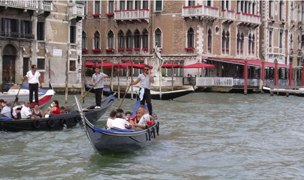


The Celtic Stone
The stone spins only clockwise or only anticlockwise because its bottom is asymmetric. It is only slightly asymmetric, which is difficult to notice initially. Similarly, a Venetiam gondola is 'almost' symmetric - at one end it is narrower by 15 cm which is sufficient enough for a gondola to be paddled from one side only.
 |
 |
Please, note how the stone 'hesitates' before changing the direction of rotation by moving up and down. As a matter of fact, in this way it temporarily accumulates spinning motion energy.

What does it have in common with the tippe top? In both toys the change in the direction of spinning motion is caused by force of friction. And it is force of friction that causes the apparent violation of the law of conservation of momentum. In fact, the momentum of the stone is absorbed by the plate, then by the table and finally by the Earth. 'Give me a Celtic Stone and I will set the Earth in spinning motion', Archimedes would say.
A spoon with an asymmetric handle (Ucke, 1996) resembles the Celtic stone in its inability to spin freely in both directions.
Does this reindeer bone with some prehistoric inscriptions (dated at 12500 B.C. and found in La Madeleine, France) spin in only one direction? Unfortunately, it is stored beyond a glass window in the British Museum.
